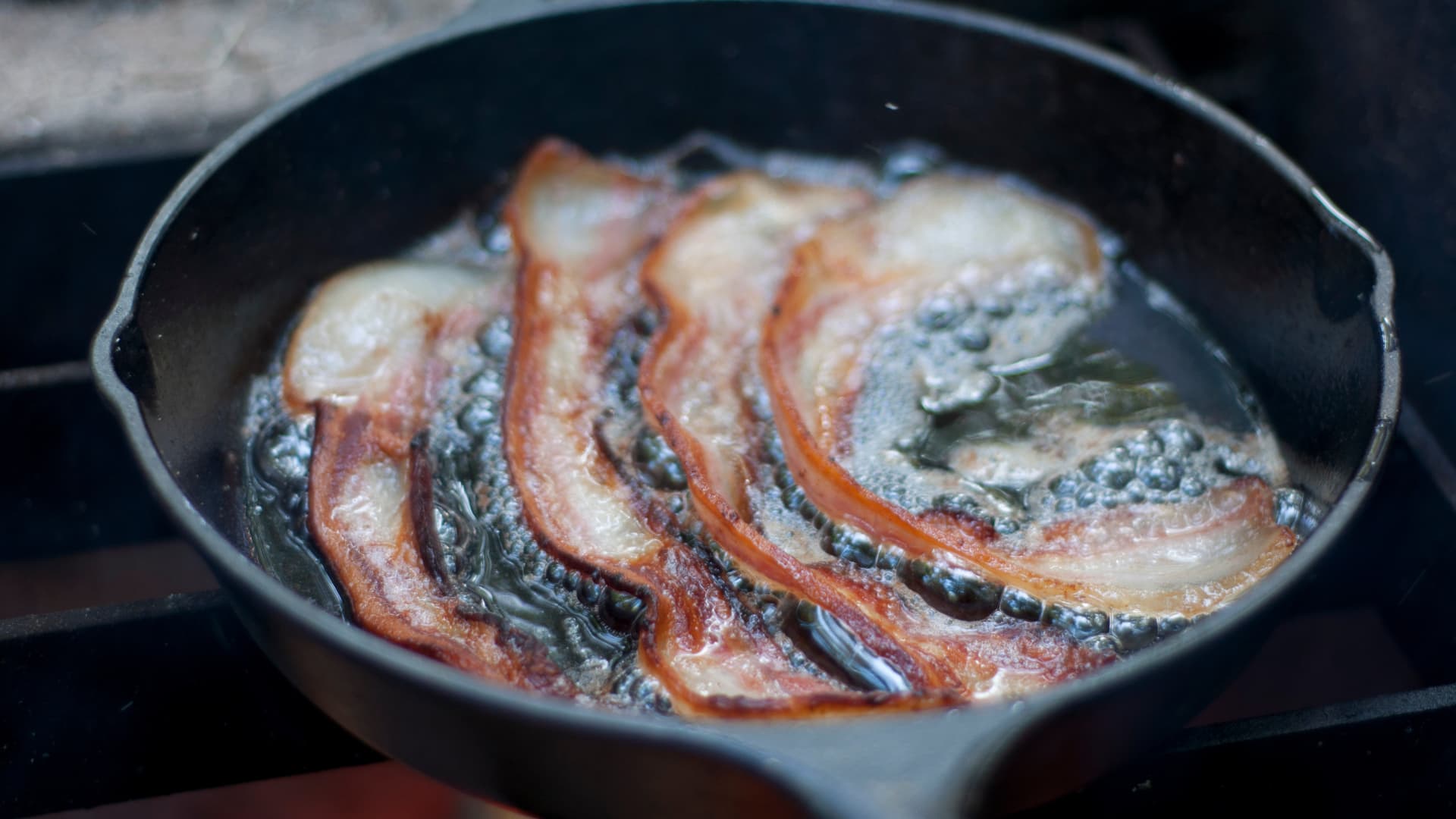Pork belly prices rose over 100% YTD, bacon is about to get pricier

Bacon frying in a pan.
Zachary Zirlin / Eyeem | Eyeem | Getty Images
Bacon is about to get even more expensive as wholesale pork belly prices approach record highs on the back of an animal welfare law in California, as well as peak summer demand.
Pork belly prices rose over 100% year-to-date from 131.59 cents per pound in January, to 270.89 cents at the end of July — just shy of the all-time high of 279.97 cents per pound in August 2021, according to data from FactSet. That’s a jump of 106%.
Wholesale pork belly prices are currently trading at 270.89 cents per pound.
And consumers are about to see even higher prices of bacon, which is primarily cut from pork bellies.
More space for pregnant sows
“Overall, I expect bacon specifically, but pork generally, in California is going to become very expensive,” said Cobank’s lead protein industry analyst, Brian Earnest.
Analysts who spoke to CNBC attributed the surge in pork prices partly to a recently imposed animal welfare regulation in California, which came into effect July 1.
California’s Proposition 12 bans the sale of pork from farms that confine pregnant sows in tiny enclosures, and spaces that are less than 24-square-feet.
This part of the law came into effect on July 1, even though other parts of the proposition — which stipulated minimum usable floorspace requirement for breeding pigs and egg-laying hens — were implemented earlier.
According to the National Pork Producers Council (NPPC), pig farmers were not properly consulted.
“Proposition 12 was developed without input from hog farmers, veterinarians or others with expertise in animal care and food safety,” the statement said.
Piglets gathering around a sow for feeding at Centennial Farm in California. Proposition 12 is a law prohibiting the confinement of pregnant sows in tiny enclosures.
Medianews Group/orange County Register Via Getty Images | Medianews Group | Getty Images
New construction of the compliant housing is estimated to cost $3,400 to $4,000 per sow, the association projected, adding that it’s about 40% more expensive than a gestation stall keeping the same number of hogs.
Those costs are set to deter many pork producers.
“Many small and medium-sized farms will be unable to bear the significant capital investment. Any costs incurred because of Proposition 12 will also fall on consumers,” the NPPC stated.
The sentiment is echoed by Cobank’s Earnest.
“Given the economic environment, hog producers will be reluctant to build Prop 12 compliant housing,” said Earnest, who added that buyers clamoring for pork products ahead of the July 1 deadline “stoked the flames” for higher belly prices.
Proposition 12 played a “major role” in the surge in prices, said Urner Barry pork market analyst, Ryan Hojnowski.
Consequently, sellers of bacon will want to keep their profit margins up — thus, the spike in pork belly wholesale prices is going to translate to higher retail and food services prices, he said.
“This of course ends up making the bacon more expensive for the consumer,” Hojnowski told CNBC in an email.
According to data provided by commodity firm Urner Barry, skinless bellies weighing 11-13 pounds — one of the categories of pork sold — surged 157% from the week of June 5 through the week of July 31. Prices jumped from 99 cents per pound to 255.2 cents per pound on a wholesale basis during that period.
BLT season
Underscoring the impact of the law is higher demand for bacon during this time of the year, coincided with lower pork production.
August is typically referred to as “BLT season,” said Earnest, referring to the popular bacon, lettuce and tomato sandwich often consumed in summer when the tomato harvest is in full swing.
BLT with fries at a restaurant in Colorado.
Glenn Asakawa | Denver Post | Getty Images
“Seasonally, pork belly prices typically peak during July and August. This year is following a similar pattern,” said Lee Schulz, associate professor at Iowa State University’s department of economics.
Pork belly prices in August last year traded at a relatively higher figure of 222.69 cents per pound compared to the rest of the year, according to FactSet.
Lee added that “hog slaughter has been steadily moving lower,” which is in line with this time of the year. However, he expects that prices would typically start to move lower toward the second half of the year.
Urner Barry’s Hojnowski similarly echoed that summer is the period where pork production dips to the lowest point in the year, which tightens the supply of fresh pork bellies on the open market.
The U.S. is the world’s second largest exporter of pork, behind Spain.
Prices of sliced bacon in major U.S. retailer outlets for the week ending Aug. 24 are 6% higher than a year ago, according to data from the United States Department of Agriculture.




